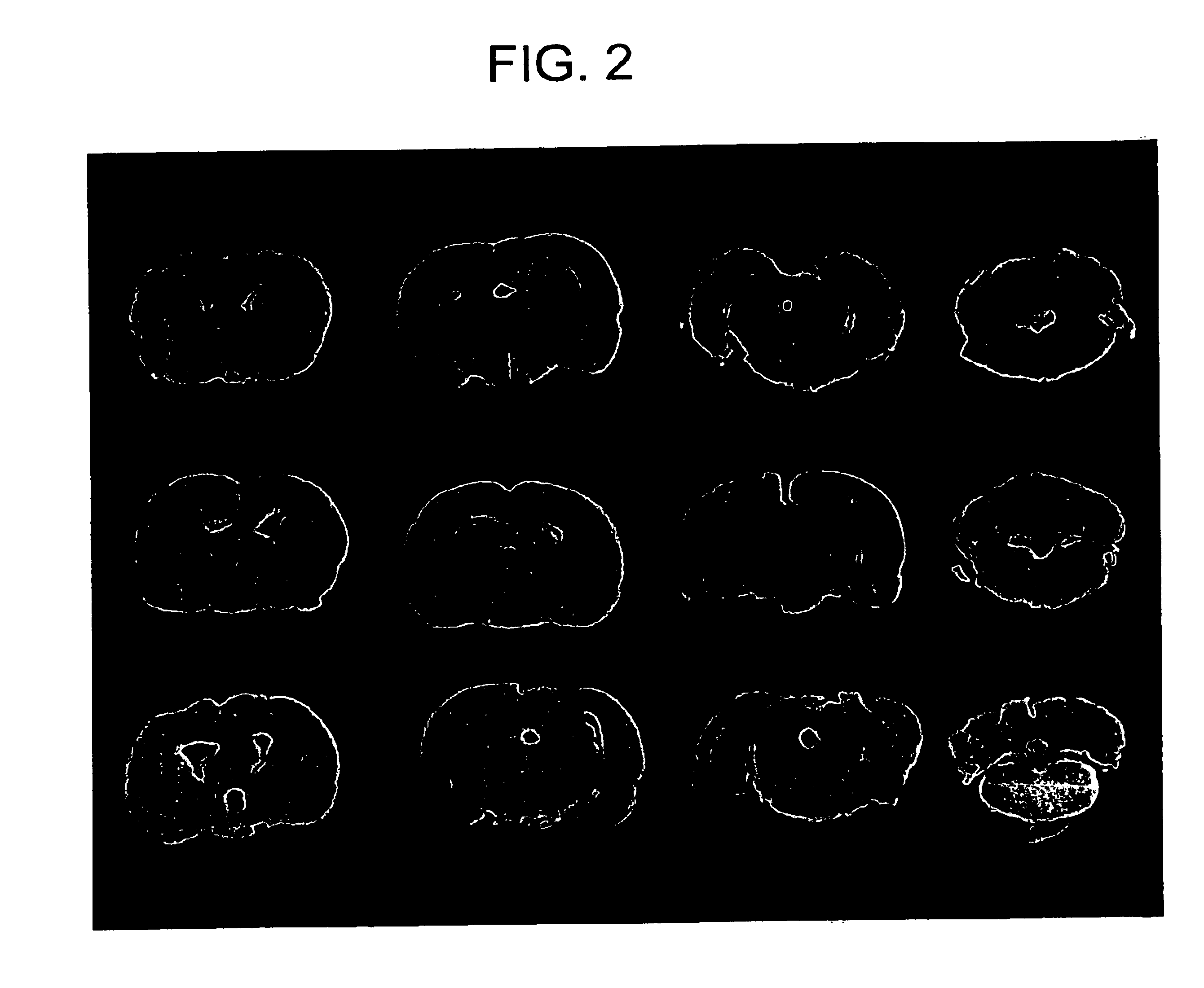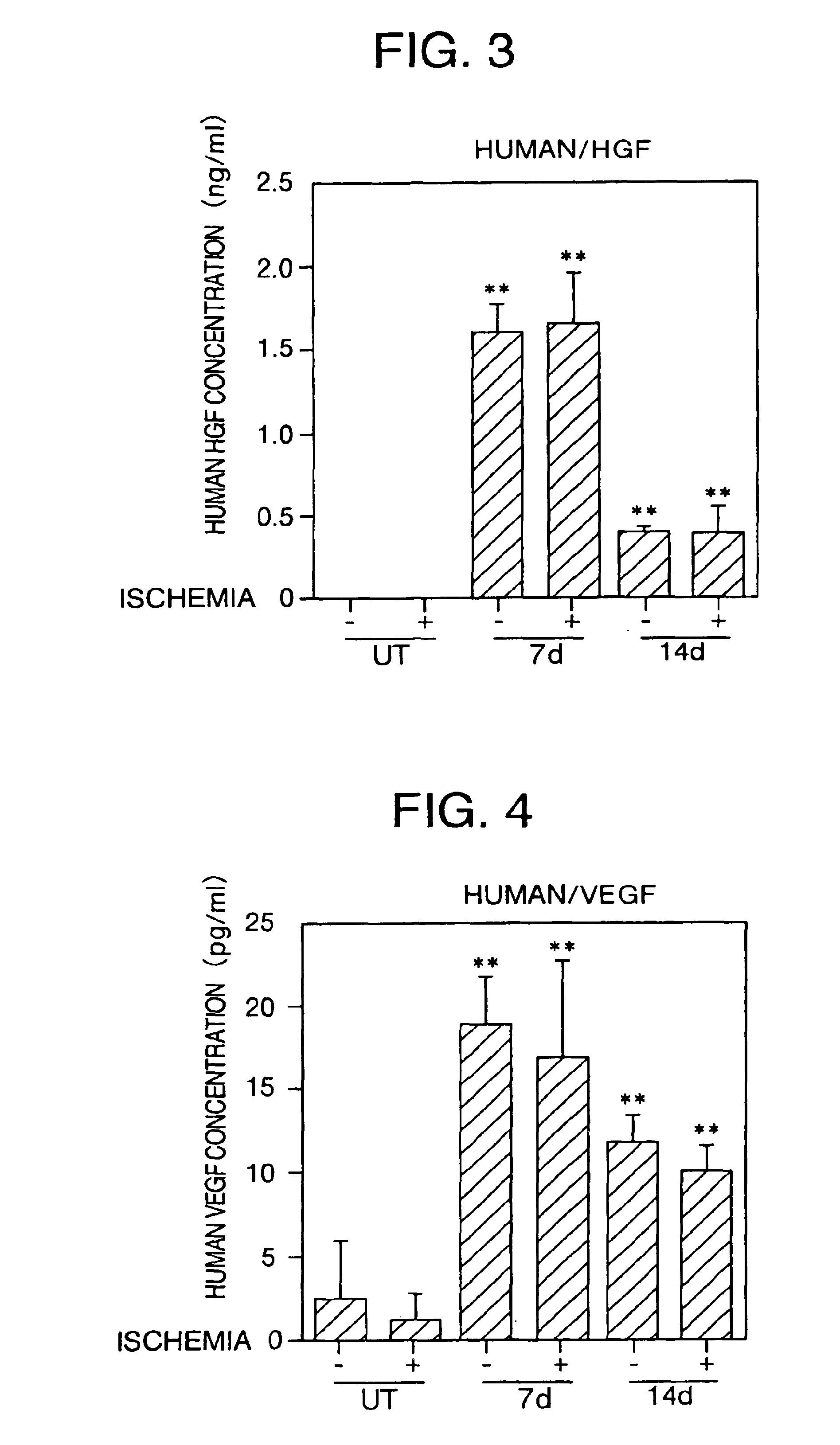Gene therapy for cerebrovascular disorders
a cerebrovascular disorder and gene therapy technology, applied in cardiovascular disorders, drug compositions, peptide/protein ingredients, etc., can solve the problems of limiting the effect of vegf on endothelial cells, no effective methods for improving the reduced and no effective strategies for improving the reduction of blood flow in these cerebrovascular disorders have been established, so as to achieve the effect of reducing blood flow and delayed neuronal death
- Summary
- Abstract
- Description
- Claims
- Application Information
AI Technical Summary
Benefits of technology
Problems solved by technology
Method used
Image
Examples
experiment i
[0086]A Study on Angiogenesis and Effect of Improving Blood Flow in the Brain with HGF Gene and VEGF Gene
Materials and Experimental Methods
1) Ligation of the Bilateral Carotid Arteries
[0087]Male Sprague Dawley rats (350-400 g; Charles River Japan, Atsugi city, Japan) were anesthetized with pentobarbital sodium (50 mg / kg, intraperitoneal), and were allowed to breathe spontaneously during surgery. By midline neck incision, the bilateral carotid arteries were exposed, and were tightly ligated by 2-0 silk.
2) Preparation of HVJ-liposome Complex
[0088]The method used to prepare HVJ-liposome is as previously described (J. Clin. Invest. 93:1458-1464 (1994); Am. J. Physiol. 271:R1212-1220 (1996)). Briefly, phosphatidyl serine, phosphatidyl choline, and cholesterol were mixed at a weight ratio of 1:4.8:2. Tetrahydrofuran was removed by rotary evaporator to allow the lipid mixture (10 mg) to deposit on the side wall of the flask. The dried lipid was hydrated in 200 μl of a balanced salt solutio...
example 1
Effect of the HVJ-liposome Delivery System on In vivo Transfection of β-galactosidase Gene
[0102]As a gene to be introduced, β-galactosidase gene (manufactured by Invitrogen, concentration in HVJ-liposome: 20 μg / ml) was used to prepare HVJ-liposome as described in the above materials and experimental method.
[0103]First, the HVJ-liposome complex was injected directly into the internal carotid artery and was allowed to reach the brain. However, in the intraarterial injection in the above carotid artery, little expression in the brain or microvascular endothelial cells was generated on day 3 and 7 after the injection (data not shown). Therefore, HVJ-liposome was injected into the lateral ventricle and the subarachnoid space. The injection of β-galactosidase gene by the HVJ-liposome method gave rise to marked expression of β-gal on day 3 and 7 after the injection (FIG. 1 and FIG. 2). When injected into the lateral brain, β-gal expression was mainly observed in the lateral ventricle and t...
example 2
In vivo Transfection of HGF Gene and VEGF Gene
[0104]In order to understand the effect of introduction of HGF gene and VEGF gene, the protein expression of these molecules in the cerebrospinal fluid (CSF) was determined by an ELISA method (n=4, each group). First, human HGF and VEGF were determined in the CSF of the control rats (treated with an expression vector in which no HGF gene or VEGF gene were introduced) before, 7 and 14 days after the obstruction of the bilateral carotid arteries, and no concentration of these proteins was detected (FIG. 3 and FIG. 4).
[0105]Next, the concentration of human HGF protein was determined in the CSF of the rats in which HGF gene (concentration in HVJ-liposome: 20 μg / ml) was introduced into the subarachnoid space immediately after the carotid artery obstruction. On day 7 after transfection, human HGF was detected but not rat HGF (FIG. 3). There were no marked differences observe between the rats (1.63±0.16 ng / ml) in which the carotid artery was ob...
PUM
| Property | Measurement | Unit |
|---|---|---|
| weight | aaaaa | aaaaa |
| pH | aaaaa | aaaaa |
| total volume | aaaaa | aaaaa |
Abstract
Description
Claims
Application Information
 Login to View More
Login to View More - R&D
- Intellectual Property
- Life Sciences
- Materials
- Tech Scout
- Unparalleled Data Quality
- Higher Quality Content
- 60% Fewer Hallucinations
Browse by: Latest US Patents, China's latest patents, Technical Efficacy Thesaurus, Application Domain, Technology Topic, Popular Technical Reports.
© 2025 PatSnap. All rights reserved.Legal|Privacy policy|Modern Slavery Act Transparency Statement|Sitemap|About US| Contact US: help@patsnap.com



